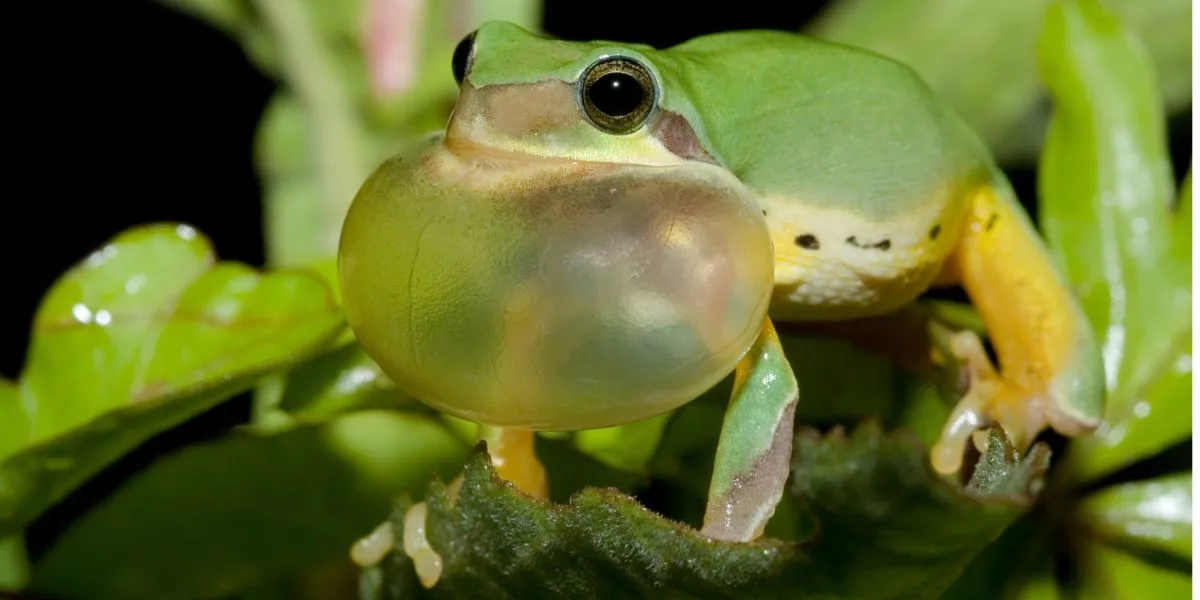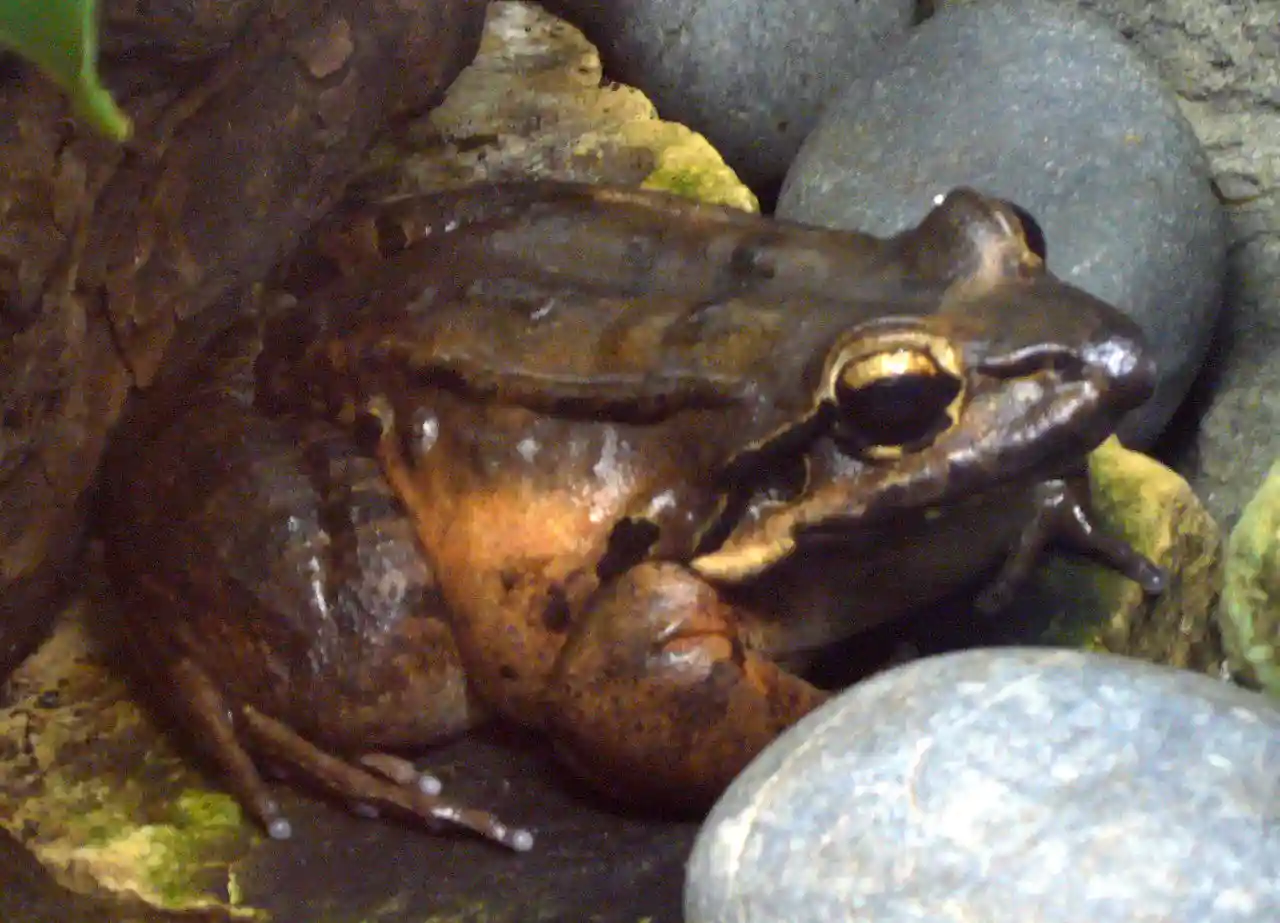Are you ready to embark on a mesmerizing journey into the world of amphibian pets? Look no further! From Axolotls to Tree Frogs, we’ve compiled the ultimate list of the Top 10 Best Amphibian Pets for Your Home.
Discover the secret world of these enchanting creatures, from the captivating axolotl with its otherworldly beauty to the charming tree frogs that will bring a touch of the rainforest into your life. Dive into the fascinating traits, care requirements, and unique personalities of each amphibian, and unlock the secrets to creating the perfect habitat for your new scaly friend.
Get ready to add a splash of wonder and delight to your home – this article is your ultimate guide to finding the perfect amphibian companion!
Axolotl
Appearance: Axolotls have a unique and distinctive appearance. They have a long, slender body with feathery external gills on the sides of their head. Axolotls have a wide, flat head with lidless eyes and a wide mouth. They come in various colors, including shades of brown, gray, and albino (pinkish with pale skin and red-colored gills).
Aquatic Lifestyle: Unlike most amphibians, axolotls retain their juvenile characteristics throughout their lives. They are fully aquatic, meaning they spend their entire lives in water, primarily freshwater. They have four legs with delicate digits and a long, finned tail, which they use for propulsion in the water.
Regenerative Abilities: One of the most remarkable features of axolotls is their incredible regenerative abilities. They have the extraordinary capacity to regrow lost body parts, such as limbs, spinal cord, heart, and even parts of their brain. This ability makes them a subject of significant scientific interest and research.
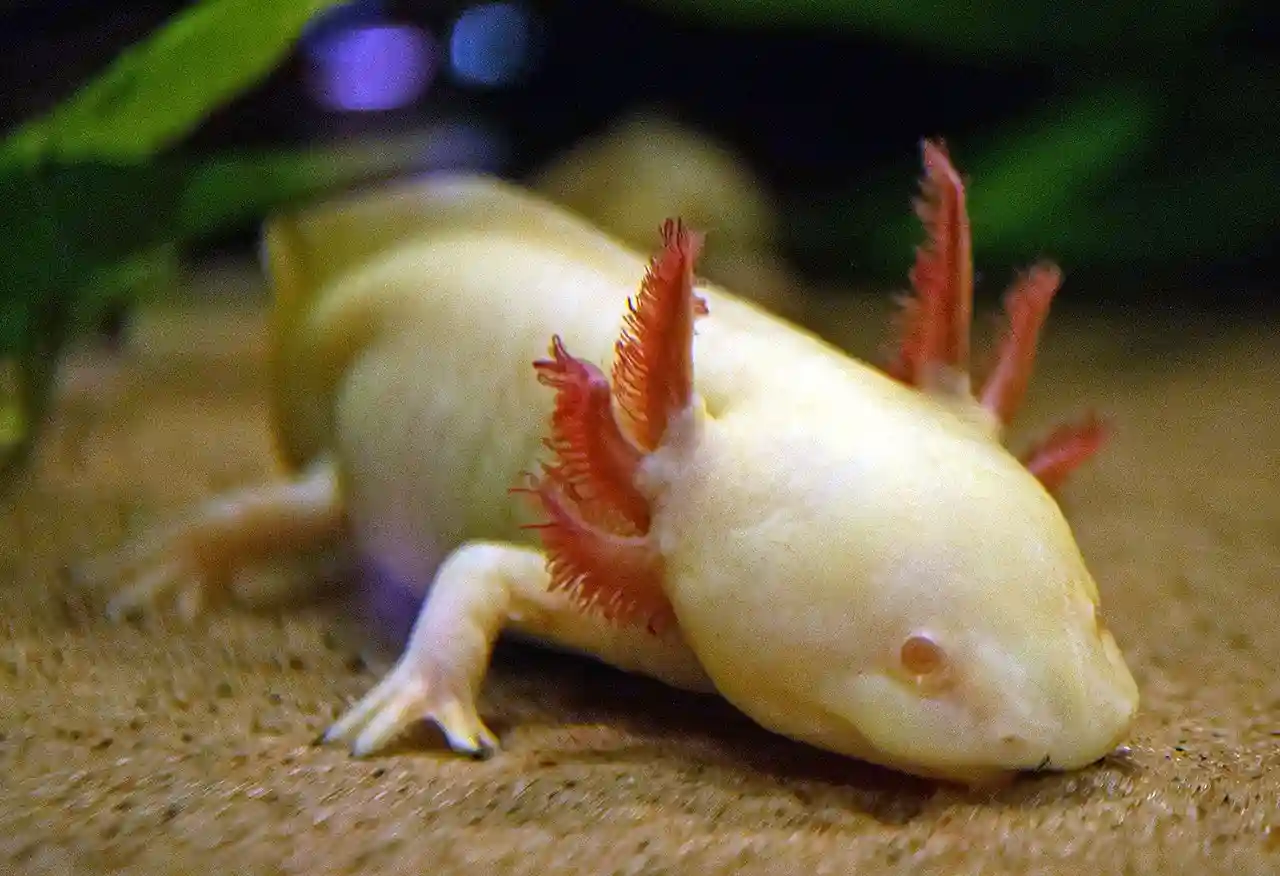
Feeding Habits: Axolotls are carnivorous and primarily feed on small aquatic prey, including worms, insects, crustaceans, and small fish. As skilled hunters, they use a combination of sight and sensory organs called “Lateral Line System” to detect movements in the water and capture their prey.
Endangered Status: Unfortunately, axolotls are currently classified as critically endangered in the wild. The main threats to their survival include habitat loss due to urbanization and pollution, the introduction of non-native species, and over-harvesting for the pet trade and scientific research. Conservation efforts are being made to protect their natural habitat and promote captive breeding programs.
Research Significance: Axolotls have become a subject of extensive scientific research due to their unique regenerative abilities. Scientists study their regenerative processes with the hope of gaining insights into human tissue regeneration, wound healing, and potential medical applications.
Cultural Significance: Axolotls hold a special place in Mexican culture and mythology. They have been revered as a symbol of transformation, regeneration, and good fortune. Their image is often depicted in art, pottery, and various forms of cultural symbolism.
Axolotls are extraordinary creatures known for their aquatic lifestyle, remarkable regenerative abilities, and cultural significance. While facing significant threats in the wild, they continue to captivate the attention of researchers and enthusiasts alike.
| Specifications | |
|---|---|
| Scientific Name | Ambystoma mexicanum |
| Habitat | Lakes and canals in Mexico |
| Conservation Status | Critically Endangered |
| Average Lifespan | 10-15 years |
| Size | Up to 12 inches (30 cm) |
| Diet | Small aquatic invertebrates |
Quick Facts
- Also known as the Mexican walking fish, but it’s not a fish.
- Has the ability to regenerate lost body parts, including limbs and even parts of its heart and brain.
- Exhibits neoteny, meaning it retains its larval features throughout its life and does not undergo metamorphosis into an adult form.
- Can come in a variety of colors, including pink, gold, white, and gray.
- Primarily aquatic and is a skilled swimmer.
- Listed as critically endangered in the wild due to habitat loss and pollution.
Dart Frog
Appearance: Dart frogs are small, brightly colored amphibians that belong to the family Dendrobatidae. They exhibit a wide range of vibrant colors, including shades of blue, yellow, orange, red, and green. Their coloration serves as a warning to predators about their toxicity.
Toxicity: Dart frogs are renowned for their potent skin toxins, which vary among species. These toxins are derived from their diet of certain small invertebrates, such as ants and mites, which contain alkaloids. The toxins make them highly toxic and potentially lethal to predators, earning them the name “poison dart frogs.”
Size: Dart frogs are generally small in size, with most species ranging from 1 to 6 centimeters in length. They have a compact body structure with smooth skin.
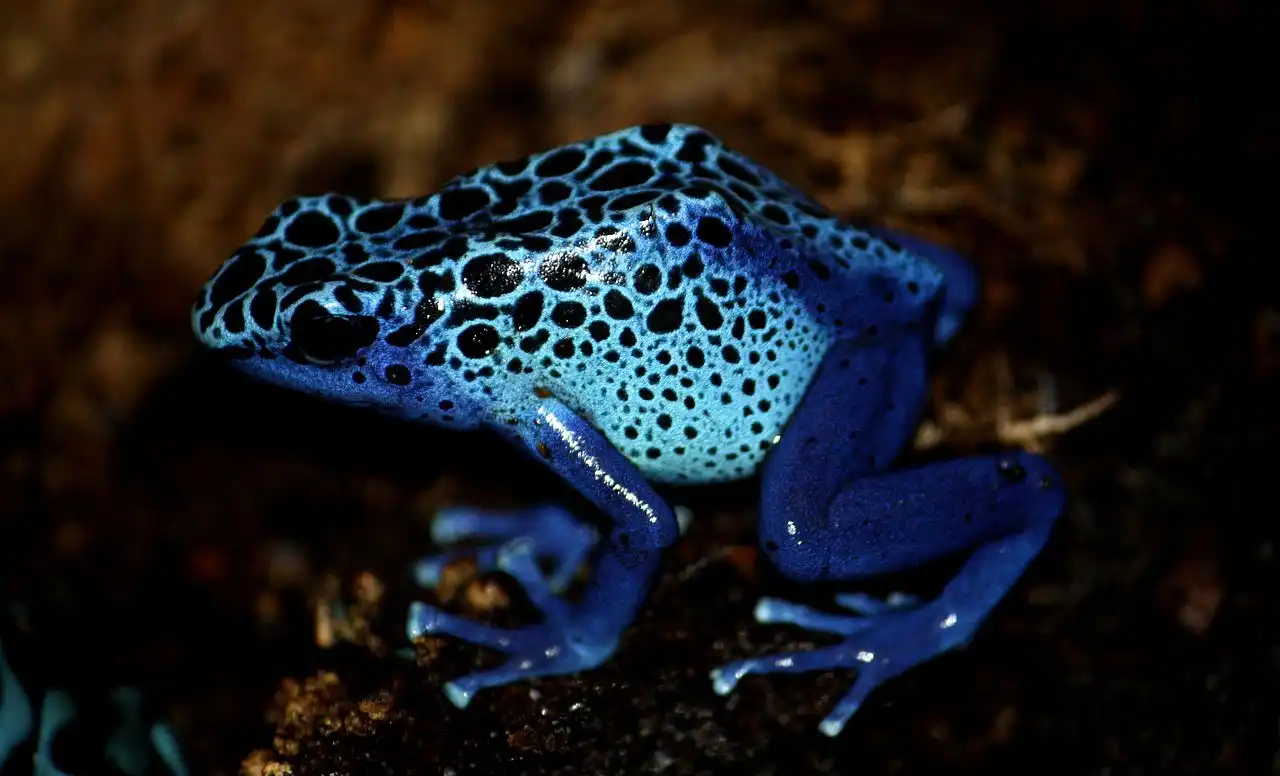
Habitat: Dart frogs are primarily found in the rainforests of Central and South America, particularly in countries like Colombia, Ecuador, and Brazil. They inhabit a variety of habitats within the rainforest, including the forest floor, leaf litter, and trees.
Behavior: Dart frogs are diurnal creatures, meaning they are most active during the daytime. They are known for their agile movements and ability to climb trees and plants. They are territorial and maintain small home ranges, usually defending a specific area for feeding and breeding.
Diet: Dart frogs are insectivores, feeding on a diet of small invertebrates such as ants, termites, beetles, and mites. Their diet plays a crucial role in the development and production of their toxic compounds.
Parental Care: Dart frogs exhibit remarkable parental care. After mating, the female lays her eggs on leaves or in water-filled crevices. Once the eggs hatch into tadpoles, the male transports them on his back to small water bodies such as bromeliad pools, where they continue their development. The male periodically visits the tadpoles to provide them with unfertilized eggs as food.
Conservation Status: The conservation status of dart frogs varies among species. While some are classified as endangered or critically endangered due to habitat loss and illegal pet trade, others have stable populations. The International Union for Conservation of Nature (IUCN) closely monitors their status and works towards their conservation.
Cultural Significance: Dart frogs have cultural significance in the indigenous communities of Central and South America. They have been used for centuries by indigenous tribes to create poisonous darts for hunting, hence their common name. In modern times, they have gained popularity in the pet trade due to their striking colors and unique behavior.
Dart frogs are small, brightly colored amphibians known for their toxicity, agile movements, and intricate parental care. While their size and toxicity make them fascinating creatures, some species face conservation challenges due to habitat loss and illegal trade.
| Specifications | |
|---|---|
| Scientific Name | Dendrobatidae |
| Habitat | Tropical rainforests |
| Conservation Status | Varies by species |
| Average Lifespan | 4-15 years |
| Size | Varies by species, typically 0.5-2.5 inches (1.2-6 cm) |
| Diet | Small invertebrates, such as ants and termites |
Quick Facts
- Known for their vibrant colors, which serve as a warning to predators that they are toxic and should be avoided.
- There are over 200 species of dart frogs, and their toxicity varies depending on their diet in the wild.
- Some dart frog species are popular in the pet trade due to their small size and bright colors.
- Their toxicity is derived from their diet of small invertebrates in the wild.
- They communicate through a series of chirps and calls.
- Parent dart frogs exhibit unique parental care, with males guarding and transporting tadpoles to water.
Eastern Newt
Appearance: The Eastern newt, scientific name Notophthalmus viridescens, is a species of salamander found in eastern North America. It undergoes metamorphosis, resulting in distinct appearances at different life stages. As a juvenile, known as the red eft, it has a bright orange or red body with dark spots. As an adult, it transforms into an aquatic form, with a greenish-brown or olive-colored body and a yellow belly.
Life Cycle: The Eastern newt has a complex life cycle that involves three distinct stages: aquatic larva, terrestrial juvenile (red eft), and aquatic adult. The aquatic larva hatches from eggs laid in water and resembles a small fish-like creature with external gills. After a few months, the larva transforms into the terrestrial red eft stage, which can last for several years. Eventually, the red eft returns to the water and transforms into an aquatic adult, adapting to an aquatic lifestyle.
Habitat: Eastern newts inhabit various freshwater habitats, including ponds, lakes, swamps, and slow-moving streams. They prefer areas with ample vegetation for cover and breeding.

Diet: As larvae, Eastern newts are primarily carnivorous, feeding on small aquatic invertebrates such as insect larvae, small crustaceans, and worms. As red efts and adults, they consume a broader range of prey, including small insects, spiders, snails, and even small fish.
Defense Mechanisms: The Eastern Newt employs various defense mechanisms to protect itself from predators. Both the red eft and adult stages produce toxic skin secretions that deter potential predators. These secretions contain a neurotoxin called tetrodotoxin, which makes the newts unpalatable or even deadly to many predators.
Conservation Status: The Eastern newt is not considered globally threatened and is listed as a species of “Least Concern” by the International Union for Conservation of Nature (IUCN). However, localized populations may face habitat loss and degradation due to urbanization and pollution.
Regeneration Abilities: Like other salamanders, Eastern newts possess impressive regenerative abilities. If they lose a limb or tail, they can regenerate the missing body part over time. This regenerative capacity has attracted scientific interest and is studied for potential applications in regenerative medicine.
Ecological Role: Eastern newts play an essential role in their ecosystems. As larvae, they serve as predators, helping control populations of aquatic invertebrates. As adults, they contribute to nutrient cycling and serve as prey for larger predators, such as birds and snakes.
The Eastern newt is a fascinating amphibian species with a complex life cycle, vibrant appearance, and intriguing defense mechanisms. Its ability to inhabit both terrestrial and aquatic habitats and its regenerative capabilities make it an ecologically significant creature in eastern North America.
| Specifications | |
|---|---|
| Scientific Name | Notophthalmus viridescens |
| Habitat | Ponds, lakes, and slow-moving streams |
| Conservation Status | Least Concern |
| Average Lifespan | 12-15 years |
| Size | Up to 5 inches (13 cm) |
| Diet | Insects, small crustaceans, worms |
Quick Facts
- Exhibits a complex life cycle, transitioning through three distinct stages: aquatic larva, terrestrial eft, and aquatic adult.
- When threatened, it can produce a toxic secretion to deter predators.
- The eft stage is brightly colored to warn predators of its toxicity.
- Can regenerate lost limbs and even parts of its heart and spinal cord.
- Eastern newts have lungs but mainly breathe through their skin and the lining of their mouth.
- They have a unique courtship behavior where males perform a “tail-fanning” display to attract females.
Fire Belly Newt
Appearance: The fire belly newt, scientific name Cynops orientalis, is a small amphibian known for its striking coloration. It has a shiny black or dark brown body with bright orange or red markings on its belly and sides. These markings serve as a warning signal to predators, indicating their toxicity.
Habitat: Fire belly newts are native to East Asia, specifically found in regions such as China, Korea, and Japan. They inhabit a variety of habitats, including slow-moving streams, ponds, marshes, and wetlands. They are semi-aquatic creatures, spending time both in water and on land.
Toxicity: Similar to other newt species, fire belly newts possess toxins in their skin secretions as a defense mechanism. These toxins contain tetrodotoxin, which is highly toxic and can deter predators from consuming them. However, it’s important to note that the toxicity levels can vary among individuals and populations.
Behavior: Fire belly newts are primarily nocturnal, becoming more active during the evening and night. They are generally shy and secretive creatures, often hiding among aquatic plants or under rocks during the day. They are relatively slow-moving and prefer calm, shallow waters.
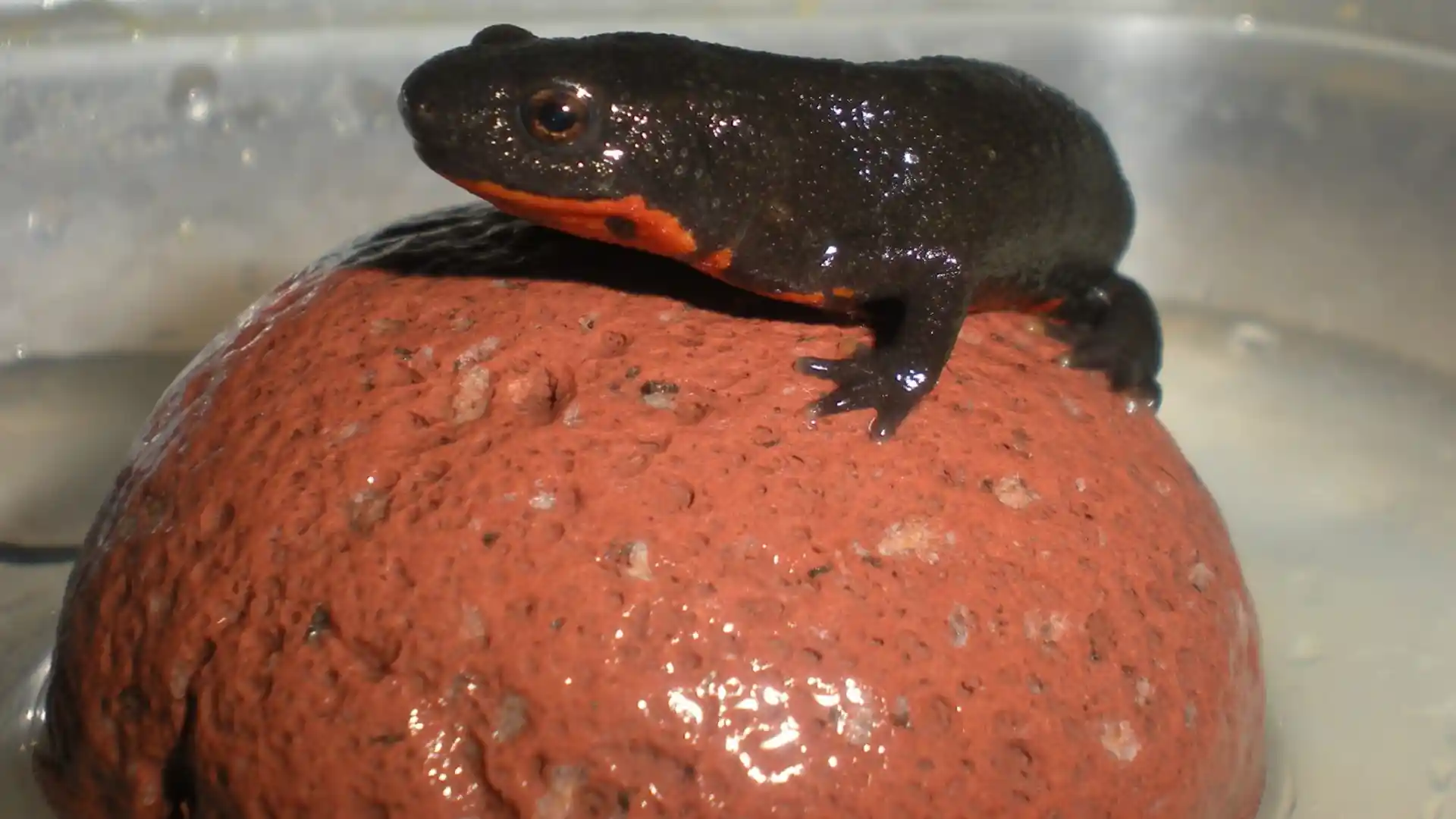
Diet: Fire belly newts are carnivorous, feeding on a diet of small invertebrates such as insects, worms, snails, and small crustaceans. They have a keen sense of smell and use their sticky tongue to capture prey.
Reproduction: Fire belly newts undergo courtship rituals during the breeding season, which typically occurs in the spring or early summer. Males display vibrant colors and perform courtship displays to attract females. After successful mating, the female lays eggs, which are attached to aquatic vegetation. The larvae hatch from the eggs and go through a metamorphosis process, eventually developing into miniature versions of the adults.
Conservation Status: Fire belly newts are not considered globally threatened and are often found in the pet trade due to their striking appearance and relative ease of care. However, localized populations may face threats from habitat loss, pollution, and collection for the pet trade. It is important to ensure responsible practices and consider the welfare of wild populations when keeping them as pets.
Cultural Significance: Fire belly newts have cultural significance in East Asian countries, particularly in China and Japan. They are often depicted in art, literature, and folklore, symbolizing luck, longevity, and protection against evil spirits.
The fire belly newt is a captivating amphibian species known for its distinctive coloration, semi-aquatic lifestyle, and toxic skin secretions. While not globally threatened, conservation efforts are necessary to protect their habitats and ensure responsible practices in the pet trade.
| Specifications | |
|---|---|
| Scientific Name | Cynops orientalis |
| Habitat | Ponds, slow-moving streams, and wetland areas |
| Conservation Status | Least Concern |
| Average Lifespan | 10-15 years |
| Size | Up to 4.5 inches (11 cm) |
| Diet | Insects, small crustace |
Quick Facts
- Has bright orange or red markings on its underside, serving as a warning to predators that it is toxic.
- Secretes toxins through its skin, which can cause skin irritation, so handling should be avoided.
- Fire belly newts have a carnivorous diet and primarily feed on small invertebrates.
- They are active both during the day and night, but prefer low-light conditions.
- During the breeding season, males display courtship behavior by waving their tails and performing a “mating dance.”
- They are popular pets and can be kept in aquariums with a semi-aquatic setup.
Horned or Pacman Frog
Appearance: The horned frog, commonly known as the Pacman frog or South American horned frog, belongs to the Ceratophryidae family. They have a robust and round body with a large mouth. The name “Pacman frog” is derived from their wide mouth and voracious appetite. They come in various colors, including shades of green, brown, or yellow, with patterns and markings that help them camouflage in their environment.
Habitat: Pacman frogs are native to the rainforests and swamps of South America, particularly in countries such as Argentina, Brazil, and Uruguay. They are primarily terrestrial frogs, spending most of their time on the ground and burying themselves in damp soil or leaf litter.
Feeding Habits: Pacman frogs are ambush predators with an insatiable appetite. They have a voracious appetite and will eat almost anything that can fit into their wide mouth, including insects, small rodents, other frogs, and even small reptiles. Their feeding behavior is known for its quick and powerful strikes.
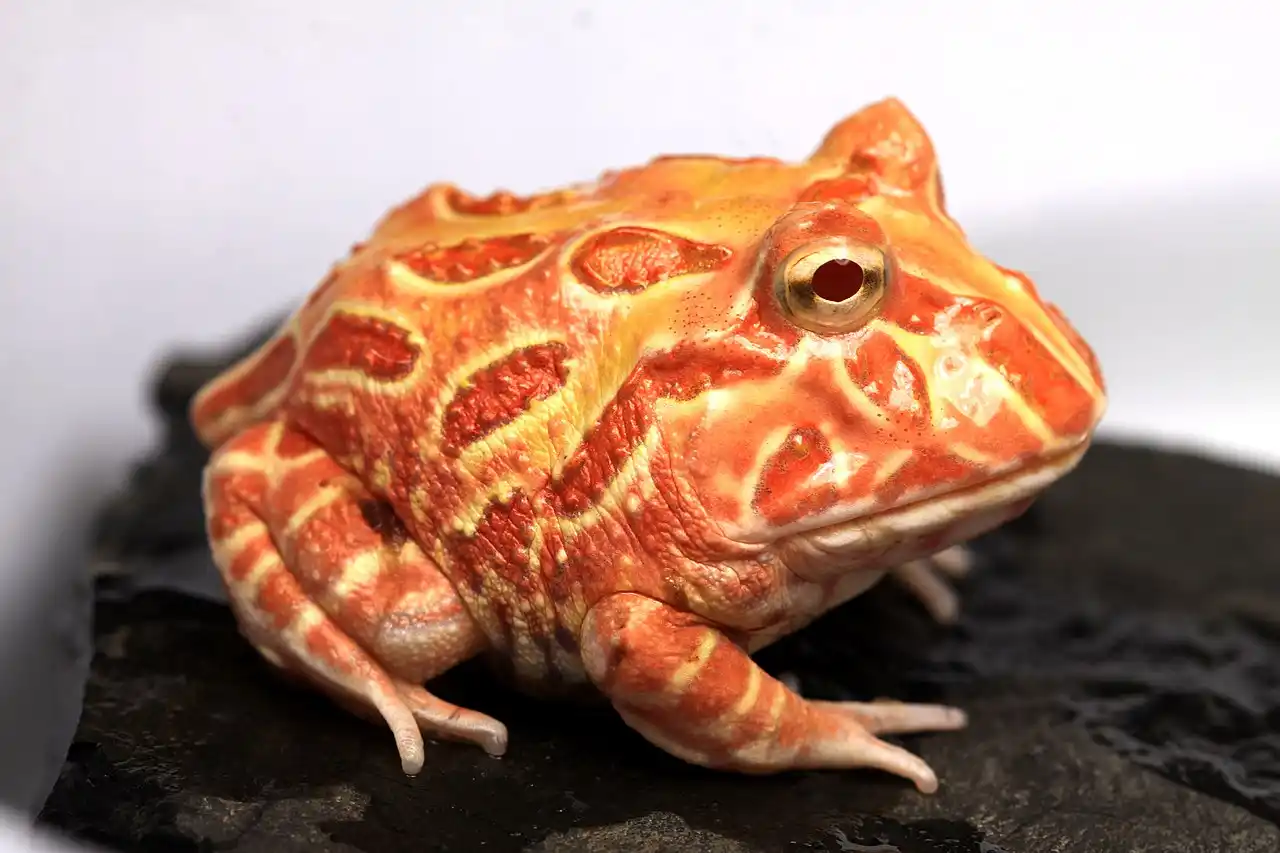
Defense Mechanisms: Pacman frogs have a unique defense mechanism. They possess bony projections above their eyes that resemble horns, giving them their name. These “horns” help protect their eyes and give them a distinct appearance. When threatened or disturbed, they may inflate their bodies, making themselves appear larger and more intimidating to potential predators.
Reproduction: Pacman frogs reproduce by laying eggs in shallow pools or bodies of water. The male attracts the female with calls, and after mating, the female lays a large clutch of eggs. The male guards the eggs until they hatch into tadpoles, which eventually undergo metamorphosis and develop into froglets.
Lifespan: The lifespan of Pacman frogs can vary depending on factors such as their environment and care. On average, they can live in captivity for 6 to 10 years, but some individuals have been known to live longer with proper care.
Popular Pets: Pacman frogs have gained popularity as pets due to their unique appearance and low maintenance requirements. They are relatively easy to care for, requiring a suitable enclosure with moist substrate, hiding spots, and a shallow water dish. However, potential owners should consider their long lifespan and commitment to providing proper care.
Conservation Status: The specific conservation status of Pacman frogs varies among species, but some populations may be impacted by habitat loss and degradation. It is important to ensure responsible sourcing and captive breeding of these frogs for the pet trade to minimize the impact on wild populations.
The Pacman frog, or horned frog, is a terrestrial amphibian known for its robust appearance, wide mouth, and voracious appetite. With their unique defensive features and popularity as pets, they have become an interesting species to observe and care for.
| Specifications | |
|---|---|
| Scientific Name | Ceratophrys sp. |
| Habitat | Tropical rainforests, marshes, and swamps |
| Conservation Status | Least Concern |
| Average Lifespan | 6-10 years |
| Size | Varies by species, typically 4-8 inches (10-20 cm) |
| Diet | Insects, small vertebrates, and even other frogs |
Quick Facts
- Known for their large mouths and voracious appetites, earning them the nickname “Pacman frog.”
- They have a distinct “horn” or ridge above each eye, giving them their name.
- Pacman frogs are ambush predators and wait for their prey to come close before lunging and swallowing them whole.
- They have a unique way of breathing by taking in air through their skin in addition to using their lungs.
- They have a wide range of colors and patterns, including various shades of green, brown, and yellow.
- These frogs have a burrowing behavior and spend a significant amount of time hiding in the substrate.
Oriental Fire Belly Toad
Appearance: The Oriental fire belly toad, scientific name Bombina orientalis, is a small-sized amphibian with a distinctive appearance. It has a rounded body and smooth skin. The upper body is typically dark brown or olive green, while the ventral side (belly) displays bright orange or red coloration. This bright coloration serves as a warning to predators about their toxic skin secretions.
Habitat: The Oriental fire belly toad is native to regions of East Asia, particularly China, Korea, and Russia. They are semi-aquatic creatures, inhabiting various freshwater habitats such as ponds, marshes, slow-moving streams, and rice paddies. They spend time both in water and on land, usually near the water’s edge.
Toxicity: Similar to other fire belly toads, the Oriental fire belly toad possesses skin toxins as a defense mechanism. These toxins are secreted through glands on their skin and can be irritating or toxic to potential predators. While the toxicity levels vary among individuals and populations, caution should be exercised when handling them to avoid potential skin irritations.
Behavior: Oriental fire belly toads are generally active during the night and exhibit both terrestrial and aquatic behaviors. They are agile swimmers and often take refuge in water to escape from predators. On land, they are slow-moving and tend to hide under leaf litter or vegetation to camouflage themselves.
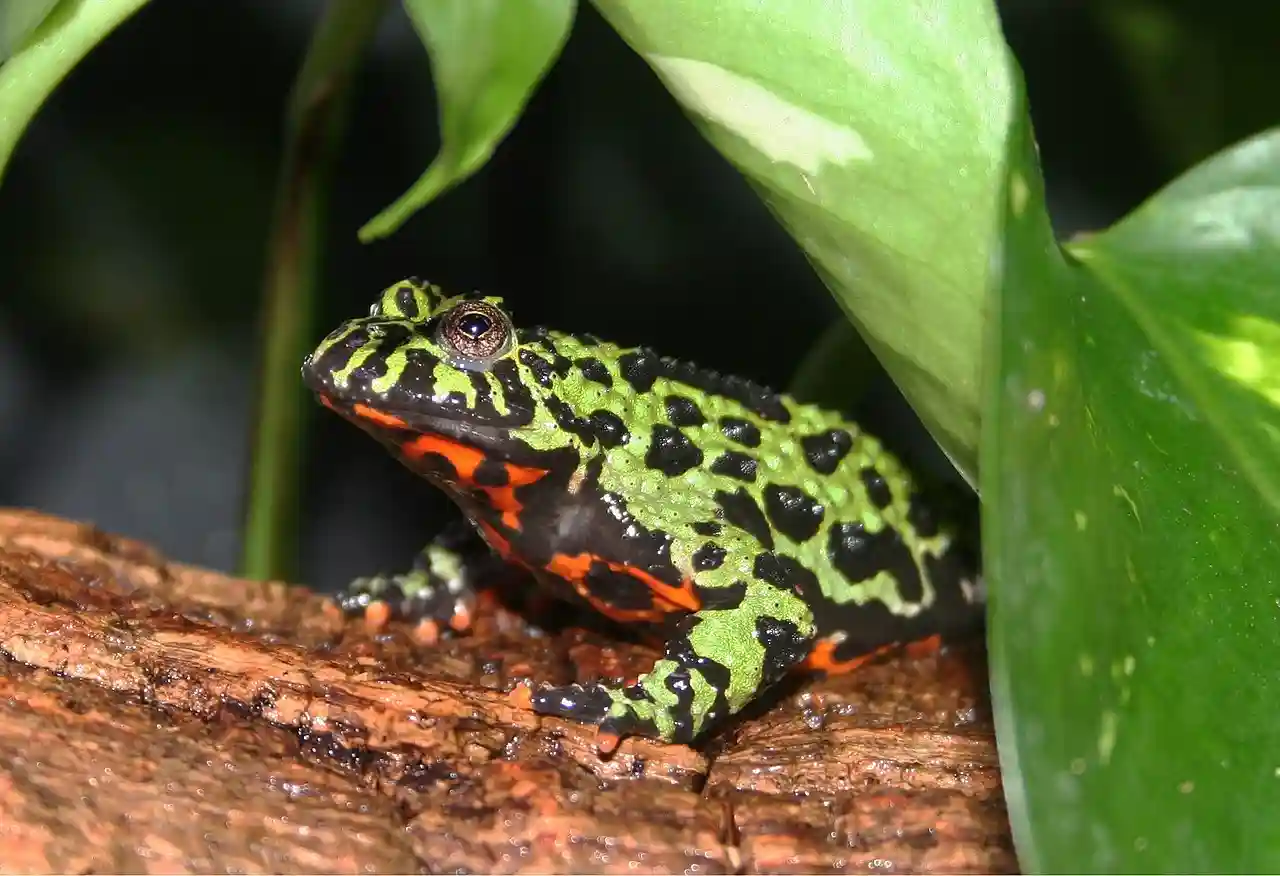
Diet: Oriental fire belly toads are carnivorous and feed on a diet of small invertebrates such as insects, worms, and snails. They have a voracious appetite and will actively hunt for prey both in water and on land. Their feeding behavior is known for their quick strikes and swallowing prey whole.
Reproduction: During the breeding season, Oriental fire belly toads engage in courtship rituals. Males produce advertisement calls to attract females. After successful mating, females lay eggs in shallow water, typically attaching them to aquatic vegetation or submerged objects. The eggs hatch into tadpoles, which undergo metamorphosis and develop into froglets over time.
Conservation Status: The Oriental fire belly toad is not considered globally threatened and is commonly available in the pet trade. However, habitat loss and pollution can pose localized threats to their populations, especially in regions experiencing rapid urbanization and agricultural development. Responsible practices in the pet trade and habitat conservation are essential for their long-term survival.
Cultural Significance: Oriental fire belly toads, like other fire belly toads, hold cultural significance in East Asian countries. They are often associated with luck and protection, and their image is depicted in various forms of art and folklore.
The Oriental fire belly toad is a small amphibian known for its distinctive appearance, toxic skin secretions, and semi-aquatic lifestyle. With their vibrant colors and fascinating behaviors, they are both captivating to observe and popular in the pet trade.
| Specifications | |
|---|---|
| Scientific Name | Bombina orientalis |
| Habitat | Wetlands, ponds, and slow-moving streams |
| Conservation Status | Least Concern |
| Average Lifespan | 10-15 years |
| Size | Up to 2 inches (5 cm) |
| Diet | Insects, small crustaceans, worms |
Quick Facts
- Named for its bright red or orange coloration on the underside, which serves as a warning to predators.
- They have toxic skin secretions, which can cause skin irritation, so handling should be avoided.
- Oriental fire belly toads are social and often found in groups or pairs.
- They are semi-aquatic and spend time both in water and on land.
- Their call is a high-pitched trill, which they use during the breeding season to attract mates.
- They have a unique reproductive behavior where males attach themselves to the female’s back during mating.
Red-Eyed Tree Frog
Appearance: The Red-Eyed Tree Frog, scientific name Agalychnis callidryas, is a visually striking amphibian known for its vibrant colors and distinctive red eyes. It has a bright green body with blue and yellow markings on its sides. The red eyes, outlined by a vertical white stripe, are its most notable feature. When at rest, the frog’s bright red eyes are hidden by its eyelids, but they become visible when startled or during nocturnal activities.
Habitat: Red-Eyed Tree Frogs are native to the rainforests of Central America, primarily found in regions including Mexico, Belize, Costa Rica, Honduras, and Panama. As their name suggests, they are arboreal and spend most of their lives in the trees. They are specifically adapted for life in the rainforest canopy.
Adaptations: Red-Eyed Tree Frogs have several adaptations that aid in their arboreal lifestyle. They have large, sticky toe pads that help them grip onto vegetation and climb trees. Their horizontal pupils provide excellent binocular vision, allowing them to accurately judge distances and navigate their environment.
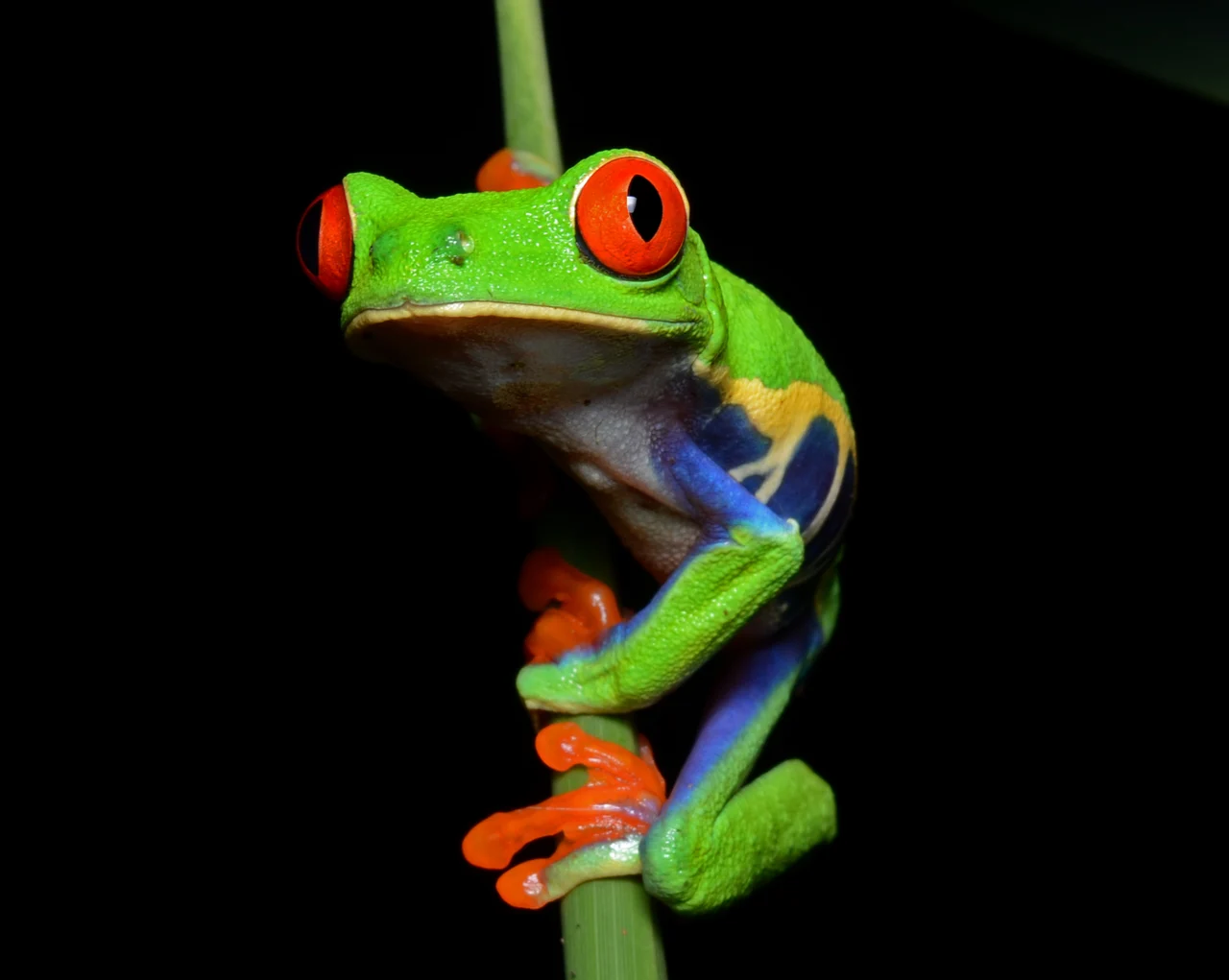
Behavior: Red-Eyed Tree Frogs are primarily nocturnal, becoming active during the night. During the day, they rest on leaves or branches, often adopting a distinctive pose where they tuck their limbs and display their vibrant colors to deter predators. When disturbed or threatened, they can suddenly open their red eyes and jump to escape. They are generally peaceful creatures.
Diet: These frogs are insectivores, feeding on a variety of small invertebrates, including crickets, moths, flies, and other small arthropods. They use their long, sticky tongues to capture prey. Their diet is essential for their survival and provides the necessary nutrients for their vibrant coloration.
Reproduction: Red-Eyed Tree Frogs have an interesting breeding behavior. Males gather near bodies of water and vocalize to attract females. After mating, the female deposits her eggs on leaves overhanging the water. When the tadpoles hatch, they drop into the water, where they undergo their development until they metamorphose into froglets.
Conservation Status: The Red-Eyed Tree Frog is not currently considered globally threatened and is commonly encountered in its native range. However, habitat loss due to deforestation and the pet trade can pose localized threats to their populations. Sustainable conservation practices and responsible pet ownership are crucial for their long-term survival.
Cultural Significance: Red-Eyed Tree Frogs are widely recognized for their striking appearance and are often featured in art, literature, and media as representatives of tropical rainforests and biodiversity. They have become popular icons for environmental awareness and conservation efforts.
The Red-Eyed Tree Frog is a visually captivating amphibian known for its bright green body, striking red eyes, and arboreal lifestyle. Their adaptations, behaviors, and cultural significance make them a beloved and emblematic species of Central American rainforests.
| Specifications | |
|---|---|
| Scientific Name | Agalychnis callidryas |
| Habitat | Rainforests and tropical lowland areas |
| Conservation Status | Least Concern |
| Average Lifespan | 5-10 years |
| Size | Up to 2.5 inches (7 cm) |
| Diet | Insects, spiders, small vertebrates |
Quick Facts
- Known for its striking appearance, with bright red eyes and vibrant green coloration on its body.
- They are primarily arboreal and spend most of their time in trees.
- Red-eyed tree frogs have excellent jumping abilities and can leap up to 5 feet (1.5 meters) in a single bound.
- They have specialized toe pads that help them cling to surfaces, including leaves and tree branches.
- These frogs are nocturnal and become active at night to hunt for insects.
- Their bright red eyes are believed to intimidate predators and confuse them when the frog opens its mouth in a defensive display.
Spotted Salamander
Appearance: The Spotted Salamander, scientific name Ambystoma maculatum, is a large, stout-bodied amphibian known for its distinct coloration. It has a black or dark gray body with vibrant yellow or orange spots covering its back and sides. Some individuals may have fewer or no spots at all. They have smooth, moist skin and a broad head.
Habitat: Spotted Salamanders are native to eastern North America and can be found in various habitats, including deciduous forests, wetlands, and vernal pools. They have a preference for areas with abundant leaf litter and moist soil, where they can burrow and seek refuge.
Life Cycle: Spotted Salamanders undergo a fascinating life cycle. They are primarily terrestrial as adults but return to the water for breeding. Breeding typically occurs during the spring when males migrate to breeding ponds or vernal pools, emitting chemical signals to attract females. After mating, females lay gelatinous egg masses attached to submerged vegetation. The eggs develop into aquatic larvae, known as “mudpuppies,” which undergo metamorphosis and transform into terrestrial adults.
Diet: As adults, Spotted Salamanders are primarily nocturnal and carnivorous. They feed on a variety of invertebrates, including earthworms, insects, spiders, snails, and small crustaceans. Their diet plays a crucial role in controlling the populations of these organisms within their ecosystems.

Defense Mechanisms: When threatened, Spotted Salamanders have several defense mechanisms. They can release a milky-white toxic substance from glands located on their back and tail, which acts as a deterrent to predators. Additionally, they can coil their bodies, tuck their heads, and raise their tails, displaying a defensive posture to make themselves appear larger and more intimidating.
Conservation Status: Spotted Salamanders are not considered globally threatened and are relatively common in their native range. However, localized populations may face threats due to habitat loss, fragmentation, and pollution. Protecting and preserving their breeding habitats, such as vernal pools, is crucial for their survival.
Ecological Role: Spotted Salamanders play an important role in their ecosystems. As both predators and prey, they contribute to the balance of populations within their habitat. They also serve as indicators of environmental health, as their presence or absence can provide insights into the overall well-being of the ecosystem.
The Spotted Salamander is a visually striking amphibian known for its black or dark gray body with vibrant yellow or orange spots. Its unique life cycle, habitat preferences, and defense mechanisms make it an interesting species to study and observe. Protecting their habitats and ensuring responsible land management practices are vital for their conservation and the maintenance of healthy ecosystems.
| Specifications | |
|---|---|
| Scientific Name | Ambystoma maculatum |
| Habitat | Woodlands, forests, and near vernal pools |
| Conservation Status | Least Concern |
| Average Lifespan | 20-25 years |
| Size | Up to 9 inches (23 cm) |
| Diet | Insects, worms, small invertebrates |
Quick Facts
- Known for its distinct black body with yellow or orange spots, providing camouflage in its woodland habitat.
- They are secretive and spend most of their time underground or hiding in leaf litter.
- Spotted salamanders have a remarkable ability to regenerate lost body parts, including limbs and even parts of their spinal cord.
- They have a unique reproductive behavior where males deposit spermatophores on the ground and lead females to them during mating.
- These salamanders are mostly active at night and have specialized chemoreceptors on their snouts to detect prey.
- Spotted salamanders are indicators of healthy forest ecosystems and play a vital role in nutrient cycling.
Tiger Salamander
Appearance: The Tiger Salamander, scientific name Ambystoma tigrinum, is a large and robust amphibian known for its bold and distinctive markings. It has a stocky body with a broad head and a long, slender tail. The coloration varies, but it typically consists of a dark base color (black, brown, or gray) with bright yellow or olive-green blotches or stripes. This striking pattern resembles the stripes of a tiger, hence its common name.
Habitat: Tiger Salamanders are native to North America and have a wide distribution, ranging from Canada to Mexico. They inhabit a variety of terrestrial and aquatic habitats, including forests, grasslands, wetlands, and even semi-arid regions. They are often found near bodies of water, such as ponds, lakes, and streams, where they breed and lay their eggs.
Life Cycle: Like other salamanders, Tiger Salamanders have a complex life cycle. They start their lives as aquatic larvae, commonly referred to as “waterdogs.” These larvae have gills and spend their early stages in water, feeding on small invertebrates. After several months to a few years, they undergo metamorphosis, transitioning into terrestrial adults. The adults breathe through lungs and have four legs for terrestrial locomotion.
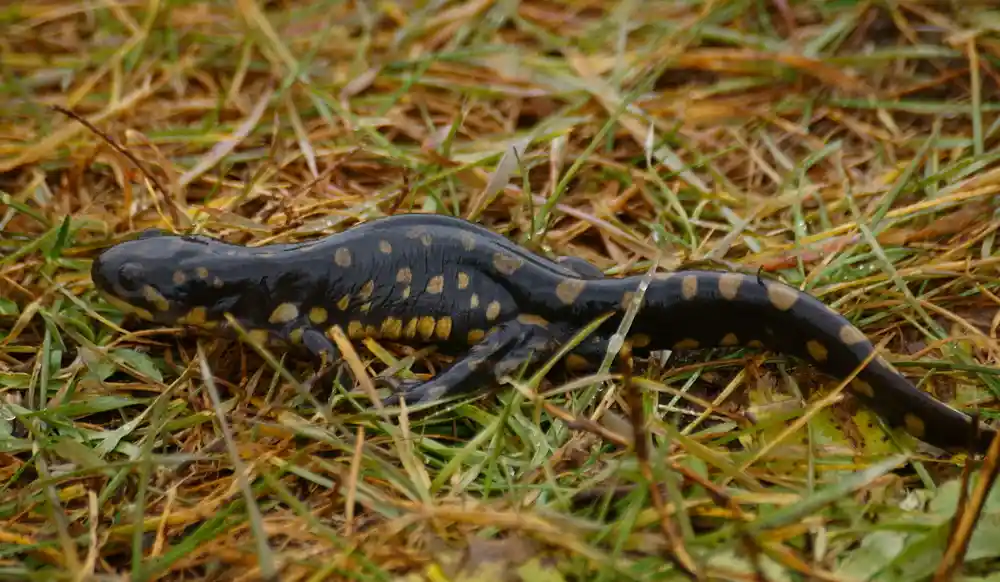
Diet: Tiger Salamanders are opportunistic predators, feeding on a variety of prey items. As larvae, they primarily consume aquatic invertebrates, such as insects, crustaceans, and small fish. Once they transform into adults, their diet expands to include a broader range of terrestrial invertebrates, including worms, spiders, insects, and small amphibians.
Behavior: Tiger Salamanders are primarily nocturnal and secretive. They are well adapted to burrowing and can often be found underground in burrows or hidden within logs, leaf litter, or other debris during the day. They are solitary animals, only coming together during the breeding season.
Conservation Status: The conservation status of Tiger Salamanders varies among different populations and subspecies. While some are considered of least concern, others are listed as threatened or endangered. Threats to their populations include habitat loss, pollution, invasive species, and collection for the pet trade. Conservation efforts focus on preserving their habitats and implementing responsible land management practices.
Special Adaptations: Tiger Salamanders have several unique adaptations. They can regenerate lost body parts, including limbs and even parts of their spinal cord. Additionally, they have a specialized gland on their tail that secretes a noxious, milky substance when they are threatened, serving as a defense mechanism against predators.
The Tiger Salamander is a visually striking amphibian known for its tiger-like markings. Its complex life cycle, adaptable habitat preferences, and unique adaptations make it an intriguing species to study. Conservation efforts are essential to protect their diverse populations and ensure the preservation of their habitats.
| Specifications | |
|---|---|
| Scientific Name | Ambystoma tigrinum |
| Habitat | Various habitats, including grasslands and forests |
| Conservation Status | Least Concern |
| Average Lifespan | 12-15 years |
| Size | Up to 13 inches (33 cm) |
| Diet | Insects, small vertebrates, worms |
Quick Facts
- Named for its bold yellow or olive-colored markings on a dark background, resembling the stripes of a tiger.
- They are excellent burrowers and spend a significant amount of time underground.
- Tiger salamanders have a large appetite and can consume prey items as large as themselves.
- They have a long larval stage that can last up to two years before metamorphosing into the adult form.
- Tiger salamanders have a wide range of color variations, including melanistic individuals with black skin.
- They are known for their ability to tolerate extreme environmental conditions, including drought and low oxygen levels.
White’s Tree Frog
Appearance: The White’s Tree Frog, scientific name Litoria caerulea, is a medium-sized tree frog known for its vibrant green coloration and adorable appearance. It has a plump, rounded body with smooth skin. The bright green coloration serves as excellent camouflage in the lush green foliage of its natural habitat. However, individuals can sometimes exhibit variations in color, ranging from greenish-brown to blue-green.
Habitat: White’s Tree Frogs are native to northern and eastern regions of Australia, including parts of Queensland, New South Wales, and the Northern Territory. They are highly adaptable and can inhabit various habitats, including rainforests, woodlands, swamps, and urban areas. As their name suggests, they are arboreal and spend most of their time in trees and vegetation.
Characteristics: White’s Tree Frogs have several distinguishing features. They have large, adhesive toe pads that enable them to climb and cling onto branches and leaves. Their eyes are striking and gold-colored with horizontal pupils. They also have a distinctive fold of skin, called a “dewlap,” on their throat that expands during vocalizations.
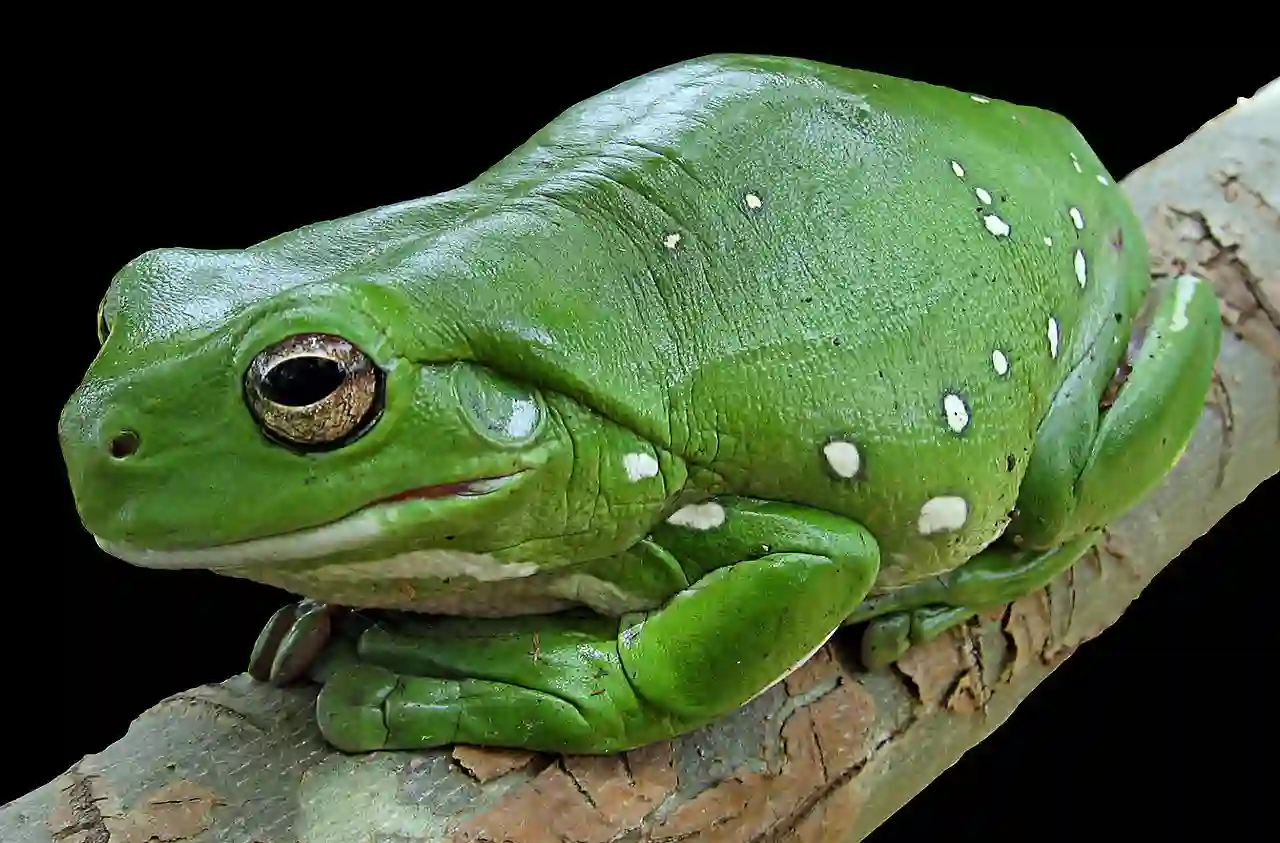
Behavior: These tree frogs are primarily nocturnal, becoming active during the night. They are excellent jumpers and climbers, using their strong legs and adhesive toe pads to navigate their arboreal environment. During the day, they seek shelter in tree hollows, crevices, or other cool and moist hiding spots.
Diet: White’s Tree Frogs are insectivorous, feeding on a variety of small invertebrates. They consume a range of prey, including insects, spiders, snails, and small vertebrates. They are sit-and-wait predators, using their well-camouflaged appearance to ambush unsuspecting prey.
Voice: White’s Tree Frogs have a distinctive call that resembles a low-pitched, repetitive “waaak-waaak-waaak” sound. Males vocalize to attract females and establish their territory during the breeding season. Their calls can be heard primarily during the warmer months.
Conservation Status: White’s Tree Frogs are not considered globally threatened and are relatively common within their native range. However, habitat loss, pollution, and the introduction of non-native species can pose localized threats to their populations. Maintaining healthy habitats and implementing responsible land management practices are crucial for their long-term survival.
Popularity as Pets: White’s Tree Frogs are popular as pets due to their charming appearance and relatively easy care requirements. They are hardy and adaptable in captivity, requiring a suitable enclosure with appropriate humidity, temperature, and ample climbing opportunities. It is important to ensure responsible sourcing of captive-bred individuals to minimize the impact on wild populations.
The White’s Tree Frog is a visually striking and adaptable amphibian native to Australia. With their vibrant green coloration, adhesive toe pads, and charming behavior, they are both fascinating to observe and popular as pets. Conservation efforts focus on protecting their habitats and promoting sustainable practices to maintain healthy populations in the wild.
| Specifications | |
|---|---|
| Scientific Name | Litoria caerulea |
| Habitat | Rainforests, wetlands, and gardens |
| Conservation Status | Least Concern |
| Average Lifespan | 16 years |
| Size | Up to 4 inches (10 cm) |
| Diet | Insects, small vertebrates, and even other frogs |
Quick Facts
- Also known as the dumpy tree frog or Australian green tree frog, they are named after John White, a surgeon and naturalist.
- They have a unique ability to change color, becoming darker when they are cold or stressed.
- White’s tree frogs have a distinctive, deep croaking call, which is often heard during the breeding season.
- They have large, adhesive toe pads that help them climb trees and other vertical surfaces.
- These frogs are often found near human habitation and are considered a popular pet species.
- White’s tree frogs have a mutualistic relationship with bacteria that helps break down toxins in their skin secretion.
Conclusion
We’ve delved into the unique characteristics, captivating appearances, and intriguing behaviors of ten remarkable species. From the axolotl’s extraordinary regenerative abilities to the vibrant colors and toxic defenses of dart frogs, and the diverse life cycles of salamanders, each species offers a distinct allure as a potential pet.
We’ve discussed their ideal habitats, dietary needs, and conservation statuses, emphasizing the importance of responsible pet ownership and environmental stewardship. Whether you’re a seasoned enthusiast or a newcomer to the amphibian world, this article has offered valuable insights and guidance for selecting the perfect amphibian companion for your home.
So, take the plunge and welcome one of these incredible creatures into your life. Discover the joy, wonder, and companionship that can come from sharing your home with an amphibian friend.


